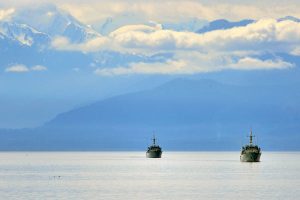MCDVs head to San Diego for RIMPAC
By Lookout on Jun 16, 2014 with Comments 0
While the training areas in the waters around Hawaii teem with 25,000 military personnel from all around the world, HMC Ships Whitehorse and Nanaimo will be at work 4,000 kilometres away.
Operating out of San Diego, California, the two Kingston-class Maritime Coastal Defence Vessels will participate in scenario-driven Naval Mine Countermeasures exercises with a task force made up of personnel from the United States, Australia, and New Zealand.
“It’s a great opportunity for us to work with allies we don’t see very often,” says LCdr Jeffrey Hopkins, Commanding Officer of Nanaimo. “They bring in elements to operations we don’t have; and learning how to utilize the specific skills and equipment we all bring is an integral and hugely beneficial part of the exercise.”
During the exercises both Whitehorse and Nanaimo will use different specialized mine-detection equipment.
Aboard Nanaimo will be a side-scan sonar, a torpedo-shaped piece of equipment that is towed through the water behind the vessel at variable depths, scanning the surrounding area for potential mines.
“We don’t get much time with the side-scan sonar so we’re happy to have any chance to brush up on it,” says LCdr Hopkins. “It’s been a while, so we’ve been hard at work training on it and making sure the newer crew members know all the ins and outs.”
Whitehorse will be tasked with investigating and inspecting contacts Nanaimo may find. They will do this using a remotely operated vehicle and a Bottom Object Inspections Vehicle (BOIV).
“Whatever Nanaimo may find we get a team and equipment in the water to get more complete information on what it is,” says LCdr Michael Sorsdahl, Commanding Officer of Whitehorse. “We will have a team embarked from the Fleet Dive Unit (Pacific) (FDU(P)) to operate underwater Remote Operated Vehicles to investigate possible threats up close, so we’ll have the whole underwater aspect covered.”
The FDU(P) team and Whitehorse crew have been completing numerous exercise scenarios to strengthen the teamwork between the ship’s crew, equipment operators, and divers prior to RIMPAC.
“Everyone has been working very well together and I’m confident we’ll be able to fill our role in San Diego,” says LCdr Sorsdahl.
The work between Whitehorse and Nanaimo is an integral part of Maritime Forces Pacific representation at RIMPAC, and LCdr Hopkins says both crews are prepared to work closely with one another.
With a relatively high crew turnover, Nanaimo has been preparing its newer crew members for the trip. Lectures, training exercises, and work-ups have been prepping them for what is for many their first look at the world’s largest maritime exercise.
“Our crew changes all the time, and for RIMPAC we’re deploying with a mixture of regular and reserve forces,” says LCdr Hopkins. “There is a lot to consider with an undertaking such as this: the capabilities and limits of our equipment, how to deal with maritime life we might encounter, how Whitehorse conducts her operations. It’s a big undertaking but our crew is ready.”
Shawn O’Hara, Staff Writer
Filed Under: Top Stories
About the Author:






